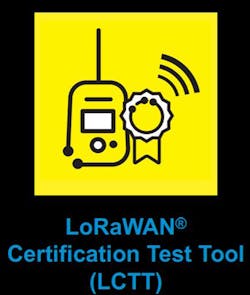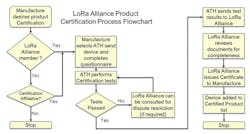Expanded Device Certification Process to Accelerate LoRa Market Growth
This article appeared in Evaluation Engineering and has been published here with permission.
Recently the LoRa Alliance, an international association backing the open LoRaWAN standard for Internet of Things (IoT) low-power wide-area networks (LPWANs), announced its Certification Affiliate option for certifying devices. Offering a path for non-LoRa Alliance members to obtain LoRaWAN device certification. The LoRaWAN certification program includes full protocol testing with interoperability and RF performance.
The Certification Affiliate program allows any device manufacturer to certify its products, ensuring they meet end-user requirements for dependability, interoperability and security as defined by the LoRaWAN standard. Historically, companies were required to be a member of the LoRa Alliance to certify their devices. However, as certification is key to global adoption, the LoRa Alliance began to offer this option. The organization still encourages companies to become members of the LoRa Alliance, as the cost to certify is lower and there are many more benefits for member companies.
Derek Wallace, LoRa Alliance Marketing Vice President
We recently had the opportunity to talk about the LoRa Alliance and the expansion of the infrastructure and community with Derek Wallace, the LoRa Alliance’s Marketing Vice President. We went over the environment and how this initiative impacts the design and development community.
Derek: “Okay. So the growth of LoRa Alliance over the last couple of years has been tremendous, especially as IoT really is beginning to mature. We currently have about 245 LoRaWAN-certified devices from different manufacturers out there in the world. It's very important to have certified devices, as they are the best bet for anyone utilizing LoRaWAN. In addition, having certified devices means that those devices will be shaped according to the inherence security that's built into the LoRaWAN specification.”
“Our LoRaWAN certification test tool, the LCTT is really important, and is the first of the two examples. This is a software package that, until two weeks ago, only member companies could obtain access to. They download this tool to their bench, and it runs a whole suite of tests against the LoRaWAN specification (Fig. 1).
This allows developers to complete the test in their own laboratories utilizing this tool, so they will have a much higher degree of certainty when they send those devices to an official test house to become LoRaWAN certified. This will save companies a lot of money, time and resources as they go through an official certification program with the test house.”
Member Experiences
Derek: “I was on the phone with a member company called Cavagna Group out of Italy a few weeks ago, and their experience is exactly why we developed the tool. They gushed about how well and how quickly and how much more easily it was for them to go through the certification process because they utilized the tool. They performed all the tests. They knew that their device was going to pass certification before they sent it to the lab. They passed certification the very first time. The length of time in the lab for the certification was significantly reduced.”
“They felt that they saved a lot of money, a lot of time and resources they could then re-allocate to different parts of their IoT business. Thankfully, they will be doing a “did you know” video for us as part of our series talking about their experience with the LCTT. So with more and more companies having this, shortening the time, cost, and resources to obtain certification of devices, that is going to help increase the number of certified devices that are out there in the world.”
The Certification Affiliate Program
Derek: The second of the impacts for why we'll see a lot more certified devices out there in the world is the certification affiliate program that we have launched as an Alliance and we announced this two weeks ago. Now I do have more slides on this lower in the deck, but what I'll say is that as a highlight is for whatever reason, some of it's IP, some of it's just company policy. Some companies are just simply not able to join the LoRa Alliance. However, they are still very involved in LoRaWAN and they manufacture devices. These are some very large companies and also small companies.
“We have three committees within the LoRa Alliance. There’s a technical committee responsible for determining the LoRaWAN specification. The protocol covers how it works, how it's interoperable, the security parameters around it, and the feature functionalities of the specifications. The certification committee, which also created the certification affiliate program that I talked about. Then there’s the marketing committee, which is all about promoting awareness, adoption and supporting members and their efforts in their LoRaWAN business.”
LoRaWAN Application Examples
Derek: “We have lots of use cases. For example, Chevron, one of our newer members, has been working with LoRaWAN for a while, and towards the end of last year announced a use case for their oil well heads in the San Joaquin Valley. They have 18,000 wells and devices in the field to operate and maintain, and many of the data points used to manage and maintain the rigs were still manually collected (Fig. 2).”
“Recently the company added 'smart lids,' in the manner of what you might find at an amusement park or in a smart city to monitor trash. The smart lids take level readings from the wells, and transmits the data over LoRaWAN using nodes with 10-year batteries that can transmit over 10 miles in ideal conditions. Chevron is now investigating the use of LoRaWAN to monitor temperature, pressure, and vibration, as well as soil samples.”
The Sky's the limit
Derek: Then we have new companies like Fleet Space and Lacuna Space (Fig. 3). They are using LoRaWAN via a satellite for back haul in remote places, where you just are not going to get cellular coverage of any kind, and the infrastructure is nonexistent as well. So, you can't use other types of communication to get up to the internet and space is just cool. It's an exciting topic for lots of people.
Derek: “One of the most well-known, but definitely not the only, use case at Lacuna is tracking elephants in Africa. Increasing the ability to track and monitor them helps game wardens and governments understand the health, behavior, and locations of the elephants. It's really exciting stuff. Then over at Fleet Space, they created a little mini gateway that has a LoRaWAN and a satellite transceiver in it, so that they have a solution for these remote places in one small little box that can be portable as well.”
“There's been a lot of interest in satellites and IoT, but the use case and the ROI hasn't always been there. These types of solutions have really changed that. And the innovations that these companies have created are now enabling use cases in these remote areas that just weren't really viable before. So, this is the beginning of a trend that's really going to increase in the coming years.”
One of the things about LoRa is that it's especially suited for satellite use, as it's the only internet of things infrastructure band that has the range. The LoRaWAN range of around, what, 500 miles is well suited for low orbit.
Derek: “It's those use cases. Again, think of agriculture and where some large farms are, think of energy, some utilitie, but more oil and gas. Think of-”
Tracking containers worldwide.
Derek: “Exactly. Going over the ocean and animals, elephants in Africa. Places where there just aren't other communication technologies that can reach those locations. And even if they could, the amount of money to build a tower or put something in place or put infrastructure just is prohibited. So the satellite capability for the backhaul to reach the internet is flexible. It has the range as you said, and now it's at a cost point that actually merits investment in those places to solve those use cases that just weren't really solvable before. It's really exciting.”
Security is Key
Derek: Security is a big focus for IoT and the LoRa Alliance. I've been involved in it as director of product management previously, trying to ensure that the solutions were deploying out there are secure. Security is a big topic. It's not just the specification itself. What's really important is the protocol and specifications, so LoRaWAN itself is very secure. But that's not enough, because in the IoT stack, you've got many attack services and attack vectors that could be leveraged to compromise a solution.”
“So implementation and management is extremely important. So, it's not just using technology, it's implementing it. Doing a proper and correct implementation, and it's amazing how often this is done incorrectly. The third piece for us is certification, which I talked about. It's people can make mistakes in developing devices utilizing any technology. The reason why secure certification for us is so important is because it absolutely tests all the security features of the LoRaWAN protocol of that device so that when they get the LoRaWAN certification mark, they know, their customers know, we know that it is a very secure part of the solution.”
“That's security at its root, it's all about trust. The mark gives you the trust in that device, regardless of where you source that device from. We're about to publish a best practices, best recommendations document. Then there's a lot of work that's continually done in the protocol itself. In fact, Johan Stokking, the CTO and co-founder of The Things Industries, is actually the chair of the security work group within the LoRa Alliance.”
Getting Certified
Derek: “The LoRa Alliance has created a certification program, but that is not the same as getting the regulatory certification marks. We have rules for becoming LoRaWAN certified, but in order to become LoRaWAN certified one needs to go through an authorized test house. There are some differences, because there are regional parameters. So North America, U.S. or Europe, Asia Pacific, and even within Asia Pacific there are some different rules depending on countries. Time on air for example, amount of data one can send at any one time.”
“First a company would send their device off to the test house. If the test house then says that it has qualified for LoRaWAN certification, then that's sent to the LoRa Alliance and Derek's team. Then they go and they do a list of activities to finalize and give the LoRaWAN certified mark for the device and also put it up on the showcase (Fig. 4).”
Derek: “What's new is in the first column, where it says LoRa Alliance member, yes or no. If it was a no previously, it would've stopped. Non-members could not obtain LoRaWAN certification from the Alliance. We're the only ones that can give that LoRaWAN certified mark. However, now that we've created a certification affiliate program, now there is a pathway for those non-members companies.”
“It's really important and the LoRa Alliance only promotes certified devices. Now clear that there are lots of non-certified devices that are out there in the world. I do not want to say that those do not perform well, but there's going to be a mix of performance from those who have developed properly to those who may have missed some things. So that's why we always promote certified devices because we know it's been empirically proven that those devices perform according to the specification.”
Looking Forward
Any last thoughts?
Derek: Certification is very important. Getting as many devices out there in the world that are certified is very important for the LoRa Alliance. It's actually much more attractive for someone to become a member of the Alliance and be able to get the LCTT as part of that membership and have cheaper per device costs for certification. But still if someone just cannot or does not want to become a member, but definitely wants certification, well now they have a path.
About the Author
Alix Paultre
Editor-at-Large, Microwaves & RF
Alix is Editor-at-Large for Microwaves & RF.
An Army veteran, Alix Paultre was a signals intelligence soldier on the East/West German border in the early ‘80s, and eventually wound up helping launch and run a publication on consumer electronics for the U.S. military stationed in Europe. Alix first began in this industry in 1998 at Electronic Products magazine, and since then has worked for a variety of publications, most recently as Editor-in-Chief of Power Systems Design.
Alix currently lives in Wiesbaden, Germany.





